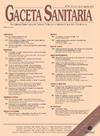自体瘤宫颈癌人群筛查的植入。瓦伦西亚社区试点研究
IF 1.5
4区 医学
Q3 HEALTH CARE SCIENCES & SERVICES
引用次数: 0
摘要
目的评估在2022年11月至2023年6月期间进行的一项试点研究的过程和结果,该研究是为在巴伦西亚社区实施基于人群的宫颈癌预防规划而设计的,该研究基于通过自我抽样进行的人乳头瘤病毒(HPV)检测。方法通过直接邮寄自采样试剂盒(FlowSWAB®,Copan)的方式,对4293名35-65岁的女性进行初步研究。为鼓励参加者参与,我们发出提醒短讯,包括调查不参与的原因。我们通过电话联系了地址不正确的女性。通过调查或随访确定的排除标准导致一些参与者被排除在外,最终样本为4170名女性。对参与和病理进行描述性和基于率的分析,评估过程和结果指标。结果HPV总患病率为7.01%,其中16基因型2.0%,其他基因型5.17%。阴道镜检出CIN1 9例(0.42%),CIN2 + 3例(0.16%),腺癌2例(0.11%)。检测到的病理比例最高的是基因型16。参与率为45.49%,较年轻的年龄组、外国出生的个人、就业妇女、慢性病患者、没有住房的人以及收入水平较低的人的参与率较低,存在统计学上的显著差异。在收到第一条短信后,短信提醒的参与率提高了10.84%,在55-65岁的女性中效果更明显。不参与的最常见原因是缺乏信息(13.3%)。联系医疗保健专业人员可显著提高地址不正确的妇女的参与率(参与率为71.42%)。结论研究结果证实了筛选程序的正常运行,支持了试点模型的可行性,尽管参与率低于预期。确定了主要缺陷,包括接触合格人群的挑战、效率低下的流程和数据管理的复杂性。实现一个可互操作的信息系统可以优化这些方面。为了提高参与度,提高对该项目和筛查技术的认识至关重要。事实证明,提醒短信和直接与医疗保健专业人员联系等策略是有效的。本文章由计算机程序翻译,如有差异,请以英文原文为准。
Implantación del cribado poblacional de cáncer de cérvix con autotoma. Estudio piloto en la Comunidad Valenciana
Objective
To evaluate the processes and outcomes of a pilot study designed for the implementation of the Population-Based Cervical Cancer Prevention Program in the Valencian Community, based on human papillomavirus (HPV) detection through self-sampling, conducted between November 2022 and June 2023.
Method
A pilot study was conducted, inviting 4293 women aged 35–65 years through direct mailing of self-sampling kits (FlowSWAB®, Copan). To encourage participation, reminder SMS messages were sent, including a survey on reasons for non-participation. Women with incorrect addresses were contacted by phone. Exclusion criteria identified through the survey or follow-up led to the exclusion of some participants, resulting in a final sample of 4170 women. A descriptive and rate-based analysis was conducted on participation and pathology, assessing process and outcome indicators.
Results
The overall prevalence of HPV was 7.01% (2.0% for genotype 16 and 5.17% for other genotypes). Colposcopies detected 9 cases of CIN1 (0.42%), 3 cases of CIN2 + (0.16%), and 2 adenocarcinomas (0.11%). The highest proportion of detected pathology was associated with genotype 16. Participation was 45.49%, lower among younger age groups, foreign-born individuals, employed women, those with chronic diseases, those without a residential unit, and those with lower income levels, with statistically significant differences observed. SMS reminders increased participation by 10.84% after the first SMS, with a greater effect among women aged 55–65 years. The most common reason for non-participation was lack of information (13.3%). Contacting a healthcare professional significantly improved participation among women with incorrect addresses (71.42% participation rate).
Conclusions
The study results confirm the proper functioning of screening procedures, supporting the feasibility of the pilot model, although participation was lower than expected. Key deficiencies were identified, including challenges in reaching the eligible population, inefficient processes, and data management complexities. Implementing an interoperable information system could optimize these aspects. To improve participation, raising awareness of the program and screening techniques is crucial. Strategies such as reminder SMS messages and direct contact with healthcare professionals have proven effective.
求助全文
通过发布文献求助,成功后即可免费获取论文全文。
去求助
来源期刊

Gaceta Sanitaria
医学-公共卫生、环境卫生与职业卫生
CiteScore
4.10
自引率
5.30%
发文量
80
审稿时长
29 days
期刊介绍:
Gaceta Sanitaria (Health Gazette) is an international journal that accepts articles in Spanish and in English. It is the official scientific journal of the Sociedad Española de Salud Publica y Administración Sanitaria (Spanish Society of Public Health and Health Administration) (SESPAS).
The Journal publishes 6 issues per year on different areas of Public Health and Health Administration, including:
-Applied epidemiology-
Health prevention and promotion-
Environmental health-
International health-
Management and assessment of policies and services-
Health technology assessments-
Health economics.
The editorial process is regulated by a peer review system. It publishes original works, reviews, opinion articles, field and methodology notes, protocols, letters to the editor, editorials, and debates.
 求助内容:
求助内容: 应助结果提醒方式:
应助结果提醒方式:


